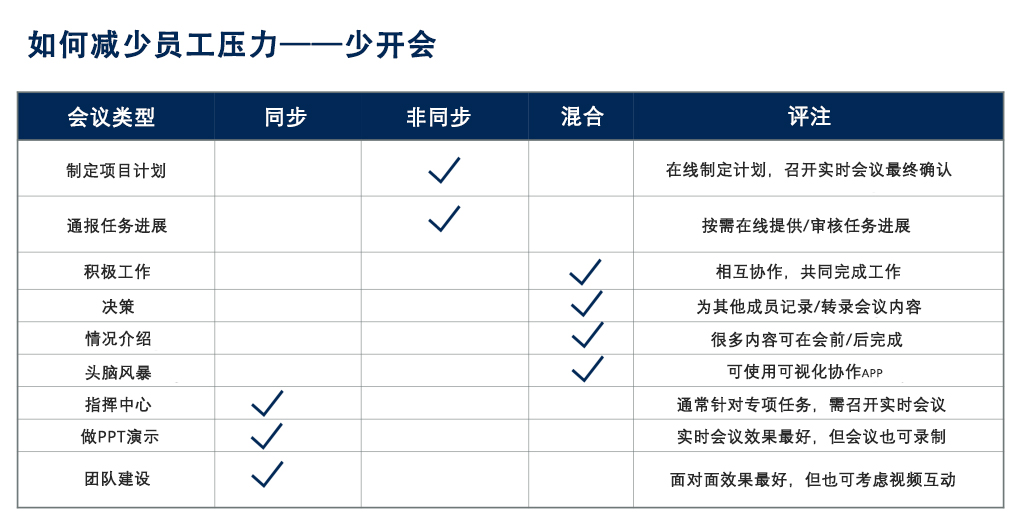
大部分会议都可以归为九类:通报进展、听取报告、头脑风暴等等。根据Gartner公司最近发布的研究,在九种会议类型中,只有三种需要全体成员同时参加,包括做PPT演示、团队建设和指挥中心(此时团队往往需要对某一专项工作做出决策或对外部事件进行回应。)
团队会议过多可能会产生负面影响,比如降低效率、浪费公司的时间和经费等。反过来说,减少不必要的会议能够提高员工参与度和产出,防止员工产生倦怠感。当前,企业领导们正在寻求对抗“视频会议疲劳”的解决之道、提升员工的幸福感、提供灵活的选择等,这一切都是为了提高工作效率——从团队日历中删除重复的会议可能会大有帮助。
Gartner的副首席分析师塔潘·乌普曼宇在该公司举办的数字职场峰会(Digital Workplace Summit)上说:“如果公司真的重视而且希望降低员工的整体倦怠感和压力,他们就可以认真研究一下每周的工作安排,找一找哪些会议能够从同步会议或实时会议转变为非同步或混合模式。”
同步会议是指需要所有员工同时出席的会议;在虚拟会议中,就意味着每个人需要同时开着摄像头参加同一场Zoom视频会。非同步会议可以通过电子邮件、Slack,或者使用其他协作工具来实现与开会相同的效果。不要求员工在特定的时间参会,也不要求实时参会。混合模式是两者结合。
乌普曼宇说,领导者应该考虑取消讨论项目计划和通报最新进展的会议,这些会议的内容能够采用非同步的方式进行线上分享、起草、审核和编辑。
“如果想通报项目进展,离线模式和开实时会议的效果一样好。”他说,“所以为什么不把内容放到一个可以编辑的文件中……任何想了解任务进展的人都能够查阅这个文件。”
某些会议类型更适合混合模式:积极工作、头脑风暴、汇报和团队决策。它们往往会用到可视化组件(例如幻灯片或视频)和文档(比如会议记录和议程)。但仍然不需要每个团队成员都同时出席。
乌普曼宇说:“这种情况下,混合模式是更好的选择,会前先将议程中不太重要的部分通过(异步协作工具)进行讨论,再开会”讨论主要议题并做出最终决策。

提高此类会议的灵活性还可以提升来自不同地区、使用不同工作模式的员工的参与度——这是人力资源主管和多元包容部门主管最关心的问题。研究显示,远程办公的员工、女性以及来自弱势群体的员工在全体会议上的声音往往更小。让员工以非同步模式参与能够提高团队参与度,加大集思广益的范围。
“成功的协作和混合模式的关键在于能够用平等流畅的方式会面、讨论、做决策并根据议程采取行动。”乌普曼宇说,“按照目前的开会方式,可以肯定的是,远程办公的员工会有被冷落的感觉……从而引起摩擦、沮丧和不满。”(财富中文网)
译者:Agatha
大部分会议都可以归为九类:通报进展、听取报告、头脑风暴等等。根据Gartner公司最近发布的研究,在九种会议类型中,只有三种需要全体成员同时参加,包括做PPT演示、团队建设和指挥中心(此时团队往往需要对某一专项工作做出决策或对外部事件进行回应。)
团队会议过多可能会产生负面影响,比如降低效率、浪费公司的时间和经费等。反过来说,减少不必要的会议能够提高员工参与度和产出,防止员工产生倦怠感。当前,企业领导们正在寻求对抗“视频会议疲劳”的解决之道、提升员工的幸福感、提供灵活的选择等,这一切都是为了提高工作效率——从团队日历中删除重复的会议可能会大有帮助。
Gartner的副首席分析师塔潘·乌普曼宇在该公司举办的数字职场峰会(Digital Workplace Summit)上说:“如果公司真的重视而且希望降低员工的整体倦怠感和压力,他们就可以认真研究一下每周的工作安排,找一找哪些会议能够从同步会议或实时会议转变为非同步或混合模式。”
同步会议是指需要所有员工同时出席的会议;在虚拟会议中,就意味着每个人需要同时开着摄像头参加同一场Zoom视频会。非同步会议可以通过电子邮件、Slack,或者使用其他协作工具来实现与开会相同的效果。不要求员工在特定的时间参会,也不要求实时参会。混合模式是两者结合。
乌普曼宇说,领导者应该考虑取消讨论项目计划和通报最新进展的会议,这些会议的内容能够采用非同步的方式进行线上分享、起草、审核和编辑。
“如果想通报项目进展,离线模式和开实时会议的效果一样好。”他说,“所以为什么不把内容放到一个可以编辑的文件中……任何想了解任务进展的人都能够查阅这个文件。”
某些会议类型更适合混合模式:积极工作、头脑风暴、汇报和团队决策。它们往往会用到可视化组件(例如幻灯片或视频)和文档(比如会议记录和议程)。但仍然不需要每个团队成员都同时出席。
乌普曼宇说:“这种情况下,混合模式是更好的选择,会前先将议程中不太重要的部分通过(异步协作工具)进行讨论,再开会”讨论主要议题并做出最终决策。
资料来源:Gartner
提高此类会议的灵活性还可以提升来自不同地区、使用不同工作模式的员工的参与度——这是人力资源主管和多元包容部门主管最关心的问题。研究显示,远程办公的员工、女性以及来自弱势群体的员工在全体会议上的声音往往更小。让员工以非同步模式参与能够提高团队参与度,加大集思广益的范围。
“成功的协作和混合模式的关键在于能够用平等流畅的方式会面、讨论、做决策并根据议程采取行动。”乌普曼宇说,“按照目前的开会方式,可以肯定的是,远程办公的员工会有被冷落的感觉……从而引起摩擦、沮丧和不满。”(财富中文网)
译者:Agatha
Most meetings fall under one of nine categories—status updates, debriefs, and brainstorming, to name a few. Of the nine meeting types, only three require that all employees attend at the same time, according to recently released research from Gartner. That truncated list includes presentations, team building, and command center (when teams make key decisions, often on an ad-hoc basis or in response to an external event).
Excessive team meetings can have negative consequences, tanking productivity and wasting company time and money. On the flip side, cutting back on superfluous meetings can improve engagement and output, and prevent employee burnout. As business leaders seek to combat “Zoom fatigue,” support employee well-being, and offer flexibility—all in an effort to drive workplace productivity—removing regularly-occurring meetings from team calendars can go a long way.
“If organizations are actually looking forward and serious about bringing down the overall burnout and stress on the employees, they can look into the work week and find out what are the meetings that actually can be transformed from synchronous, or live, to an asynchronous or blended approach,” said Tapan Upmanyu, associate principal analyst at Gartner, at the company’s Digital Workplace Summit.
Synchronous meetings are those where the presence of all employees is required at the same time; in a virtual setting this could mean everyone in a Zoom call with cameras on. Asynchronous meetings can occur via email, Slack, or utilize other collaboration tools to deliver the same outcomes as a meeting. They do not require every individual’s attendance at a specific time, nor does employee participation happen in real time. A blended approach refers to a mix of the two.
Leaders should consider axing meetings that discuss project planning and status updates, which can be shared, developed, reviewed, and edited online asynchronously, Upmanyu said.
“Status updates in live meetings are as good as status updates in an offline mode,” he said. “So why not take it down to a co-editable document…and anyone who wants to know and understand the updates of the task going on can go into that file.”
Certain meeting types are better suited for a blended model: active work, brainstorming, debriefs, and making team decisions. They typically involve visual components such as slideshows or videos, and documentation such as meeting notes and an agenda. But they still do not require every team members’ live attendance.
"It is better to use a blended approach when the agenda’s less important points are actually discussed prior to the meeting through [asynchronous collaboration tools] and then go into the meetings” to discuss primary points and finalize decisions, Upmanyu said.
Improving flexibility around these kinds of meetings can also allow for greater participation across geographies or work models—a top concern for HR leaders and D&I heads. Remote employees, women, and those from underrepresented groups tend to be less vocal in all-hands meetings, research shows. Allowing workers to participate asynchronously can bolster team involvement and widen the breadth of ideas sourced.
“The key to a successful collaboration and hybrid model is the ability to meet, discuss, decide and act upon agendas in an equal and frictionless manner,” Upmanyu said. “The way meetings have been conducted so far, it is certain that the remote employees actually feel a little left out…leading to friction, frustration, and dissatisfaction.”






